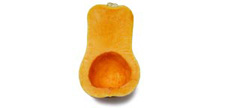Calories In Squash

Not Many Calories In Squash
As far as the number of calories in squash is concerned, summer squash is your best bet if you are counting every single calorie. A typical summer squash has about a third of the calories per equal size serving than that of a winter squash, but the calorie count is also very low in winter squash.
Low In Calories - Add the fact that most of the favorite varieties, or should we say the most often grown and sold varieties of squash, are winter squash. If you don't mind about 40 extra calories per cup (60 vs. 20 for summer squash) the amount of calories in squash becomes almost a no-brainer as far as choices are concerned. Just about every part of a squash plant is edible, specifically the fruit, the blossoms, and the leaves, leaving only the stems and vines, which while probably edible, are not noted as table fare. The hard rind, usually found on the winter varieties, is not edible however. It's assumed that the number of calories in squash blossoms or leaves is somewhat less than found in the flesh.
The terms winter squash and summer squash are practically meaningless these days. It used to be that before squash could be transported in refrigerated containers, and otherwise stored in a cool environment, squash varieties that were the best keepers became know as winter squash, while those that were not were placed in the summer squash category. At what point it matured in the growing season influenced how a squash was categorized, and the so-called winter squash often had a deeper color flesh.
A Very Nutritious Vegetable - Nutritionally, winter squash and summer squash are about the same, the main difference being that the winter squash varieties are extremely rich in Vitamin A, while summer squash contains little of this vitamin. Both types are rich in Vitamin C and Vitamin B6 however, and both also provide excellent amounts of Potassium, Phosphorus, Magnesium, Calcium and Iron. Zinc and Copper in the order of 3% of the recommended daily requirement is also to be found in a cup of either type of squash. Squash is also very low in saturated fat, cholesterol (virtually zero) and sodium.
If you're worried about calories in squash, it should be how squash is prepared that you'll want to be paying attention too. Baked squash served with salt and pepper is not going to be heavy in calories. Once you add butter to the mix of course the calorie count changes. If you already use a little butter or margarine in your everyday diet, having it with squash isn't going to make a big difference in your total caloric intake.
Popular Varieties Of Squash - Let's look at a few of the more popular varieties, not worrying too much about which are winter squash and which are summer squash (most are winter). The Acorn squash is one that most people are familiar with. Shaped like an acorn as the name suggests, it is most often prepared by cutting it in half lengthwise, scooping out the soft pulp and seeds, and baking in the oven with a generous pat of butter in the cavity. The Buttercup squash is a hard shelled squash, sometime confused with the Turban squash, to which it is related. This squash lends itself to baking, mashing, steaming, and as a substitute for sweet potatoes. A hybrid of the Buttercup squash is the Autumn Cup, a favorite with gardeners because the plant normally gives high yields.
Another squash that tastes somewhat like the sweet potato is the Butternut squash, a vase-shaped squash whose flesh is a little more watery than typical for a squash plant. It has a sweet, nutty flavor though not as sweet as the Buttercup. The Gold Nugget squash, a winter variety, looks for all intents and purposes like a small (about 3 pounds) pumpkin, but definitely tastes like a squash should, and usually is served sliced and baked.
The popularity of the Hubbard squash may due to the fact that it has always been among the best keepers among the squash family. Under the right conditions, a temperature of around 50 degrees and rather high humidity, the Hubbard can keep for up to 6 months. The Hubbard is a fairly large squash, and you can often buy it by the slice. It is excellent in pies. A squash variety that is at its best when hollowed out and filled with soup, is the Turban. Turban squash, because of its shape and colors is probably used more as an ornamental on the dinner table than as a food, but you can use this variety for either purpose, or both.
Which ever variety you choose likely depends upon the intended use as much as anything else. Instead of wasting your time focusing on the number of calories in squash, concentrate on how best to prepare and enjoy the variety you end up purchasing.